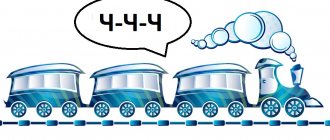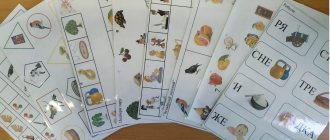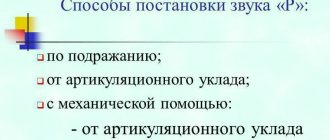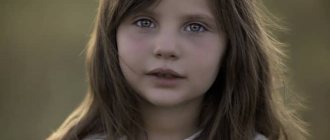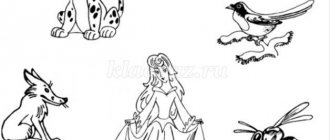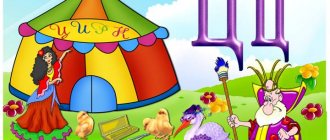Elimination of erased dysarthria
To eliminate erased dysarthria, a complex intervention is required, including medical, psychological, pedagogical and speech therapy. Medical intervention determined by a neurologist should include drug therapy, exercise therapy, reflexology, massage, physiotherapy, etc. Psychological and pedagogical intervention carried out by defectologists , psychologists, educators, parents is aimed at:
- development of sensory functions; — clarification of spatial representations; — formation of constructive praxis; — development of higher cortical functions; — formation of subtle differentiated hand movements; — formation of cognitive activity; - psychological preparation of the child for school.
Speech therapy work for erased dysarthria requires the mandatory inclusion of parents in correctional speech therapy work. Speech therapy work includes several stages. At the initial stages, work is planned to normalize the muscle tone of the articulatory apparatus. For this purpose, the speech therapist conducts differentiated massage. Exercises are planned to normalize the motor skills of the articulatory apparatus, exercises to strengthen the voice and breathing. Special exercises are introduced to improve speech prosody. An obligatory element of speech therapy classes is the development of fine motor skills of the hands.
The sequence of practicing sounds is determined by the preparedness of the articulatory base. Particular attention is paid to the selection of lexical material during automation and differentiation of sounds. One of the important points in speech therapy work is the development of self-control in the child over the implementation of pronunciation skills. Correction of erased dysarthria in preschool children prevents dysgraphia in schoolchildren.
Violation of the pronunciation aspect of speech, caused by insufficient innervation of the muscles of the speech apparatus, also refers to dysarthria (E.M. Mastyukova, M.V. Ippolitova). The leading structure of a speech defect in dysarthria is a violation of the sound pronunciation and prosodic aspects of speech. Mildly expressed brain disorders can lead to the appearance of erased dysarthria, which should be considered as the degree of manifestation of dysarthria. Faint, erased disorders of the cranial nerves can be established during long-term dynamic observation, when performing increasingly complex motor tasks. M.B. Eidinova, E.N. Pravdina-Vinarskaya describes cases of mild residual innervation disorders encountered during an in-depth examination, which underlie violations of full articulation, which leads to inaccurate pronunciation.
Erased dysarthria can be observed in children without obvious movement disorders, who have suffered mild asphyxia or birth trauma, who have a history of PEDs and other mildly expressed adverse effects during fetal development or during childbirth, as well as after birth. In these cases, mild (erased) dysarthria is combined with other signs of minimal brain dysfunction (E.M. Mastyukova). The brain of a young child has significant plasticity and high compensatory reserves. A child with early cerebral damage by the age of 4-5 years loses most of the symptoms, but a persistent violation of sound pronunciation and prosody may remain. In children with erased dysarthria, due to damage to the central nervous system and impaired innervation of the muscles of the speech apparatus, the necessary kinesthesia is not formed, as a result of which the pronunciation side of speech does not spontaneously improve.
Existing methods for correcting erased dysarthria in preschool children do not solve the problem in full, and further development of methodological aspects of eliminating dysarthria is relevant. A study of preschool children with erased dysarthria showed that, along with disturbances in the function and tone of the articulatory apparatus, a deviation in the state of gross and fine manual motor skills is characteristic of this group of children, which is consistent with the literature data of recent years.
Many works emphasize that with erased dysarthria it is necessary to develop fine motor skills of the hands . The proximity of the cortical zones of innervation of the articulatory apparatus with the zones of innervation of the muscles of the fingers, as well as neurophysiological data on the importance of manipulative activity of the hands for stimulating speech development, determine this approach to correctional work.
Children with erased dysarthria are characterized by: 1. Phonetic disorders. 2. Phonemic disorders. 3. Violation of prosody. 4. Violation of the lexico-grammatical component of the language. 5. Gross motor disorder. 6. Fine motor skills disorder of the fingers. 7. Articulatory motor disorder.
Speech therapy work to eliminate erased dysarthria may include five stages. Stage 1 - preparatory. The purpose of this stage is to prepare the articulatory apparatus for the formation of articulatory structures. It includes six areas: 1) normalization of muscle tone, 2) normalization of the motor skills of the articulatory apparatus, 3) normalization of speech exhalation, the development of a smooth, long exhalation, 4) normalization of the voice, 5) normalization of prosody, 6) normalization of fine motor skills of the hands.
Stage 2 - development of new pronunciation skills. Directions: 1) development of basic articulatory patterns, 2) determination of the sequence of work on sounds, 3) development of phonemic hearing, 4) sound production, 5) automation, 6) differentiation (differentiation by ear; differentiation of articulation of isolated sounds; pronunciation differentiation at the syllable level , words).
Stage 3 - development of communication skills. Directions: 1) development of self-control, 2) training of correct speech skills in various speech situations.
Stage 4 - overcoming or preventing secondary violations.
Dysarthria - symptoms and treatment
The following forms of dysarthria are distinguished depending on the damage to brain structures [9].
Bulbar dysarthria is a consequence of damage to the bulbar group of cranial nerves: glossopharyngeal, vagus and hypoglossal. Characterized by weakness of articulation muscles, decreased muscle tone. As a result, speech is slurred, extremely slow, and the face is depleted of facial expressions.
Subcortical dysarthria occurs with lesions of the subcortical nodes of the brain. It is distinguished by the presence of hyperkinesis - violent facial movements uncontrollable by the child. Muscle tone changes from normal to increased. The tempo-rhythmic organization of speech suffers.
Cerebellar dysarthria is observed when the cerebellum or its connections with other structures of the nervous system are damaged. It is distinguished by scanned, “chopped” speech. There is no smooth transition from one word to another.
Cortical dysarthria , as the name suggests, is associated with damage to the cerebral cortex, namely, the lower part of the anterior central gyrus of one or both hemispheres. Also, cortical dysarthria is diagnosed when the dominant hemisphere is damaged (for right-handers - left, for left-handers - right) in the lower postcentral parts of the cortex. Children with this form are good at mastering isolated pronunciation of sounds, but have great difficulty using them in the flow of speech, and sometimes skip them altogether.
Pseudobulbar dysarthria is noted with bilateral damage to the motor corticonuclear tracts connecting the nuclei of the cranial nerves of the brain stem with the cortex. Characterized by the inability to organize clear rhythmic movements. In early childhood, such a child often chokes and has difficulty chewing; at an older age, a number of speech problems are discovered due to poor mobility of the articulatory muscles; speech is extremely slurred.
There are several degrees of dysarthria [6]:
First degree. Most often they talk about erased dysarthria; in this case, defects in sound pronunciation may be barely noticeable to others. They are identified by a speech therapist and, when corrected, are particularly resistant, which means that a lot of time and effort will have to be spent. As a rule, such children are seen by a neurologist at 1-2 years of age, but thanks to the plasticity of the child’s nervous system, many symptoms are compensated for by 4-5 years, and the child “outgrows” them. An unpleasant surprise is persistent problems with sound pronunciation in preschool age.
Second degree. Defects in sound pronunciation are very noticeable to others, but overall speech remains understandable. Along with speech symptoms, psychological symptoms are also observed. Often there is a deficiency of fine and gross motor skills, some clumsiness, behavioral disorder, emotional-volitional disorder, attention deficit disorder, hyperactivity, etc.
Children with the first and second degrees of dysarthria, as a rule, have fairly intact thinking.
Third degree. Understanding the speech of a dysarthric child is difficult for others. It is often not clear what the child is saying. Non-speech symptoms are extremely pronounced. A critical level of speech underdevelopment has the most negative impact on the behavior and thought processes of the child. We can talk about disruption of almost all mental functions: memory, attention, thinking, emotional-volitional sphere, etc.
The fourth is the most severe degree. Speech is almost always incomprehensible even to the closest people or is absent altogether.
You can count on complete correction of sounds in speech with the first and second degrees. The third and fourth degrees are diagnosed for severe lesions, for example, in children with cerebral palsy (CP), the prognosis for correction here is less optimistic.
Dysarthric disorders in children and adults. Clinic and recovery
Humanitarian Academy for Retraining of Social Workers (MISAO)
Professional retraining program
Clinical speech therapy. Speech therapy assistance to patients with speech disorders and other higher mental functions (620)
Discipline:
Dysarthria. Correctional and speech therapy work to eliminate violations of phonation (external) design of utterances
Practical task 3 ,
Module 3. Features of correctional and speech therapy work to overcome dysarthric speech disorders
Completed:
student
Svechkareva-Kovalinskaya Ekaterina Nikolaevna
Teacher:
Shopina Svetlana Andreevna
Moscow
- 2021
Practical task No. 3.
Goal: to teach how to master various methods and techniques of correctional, developmental and restorative work for dysarthria, the ability to make a differential choice of correctional and developmental techniques for different forms of dysarthria.
Task 1. Describe the symptoms of bulbar dysarthria and draw up a plan for correctional and speech therapy work to restore speech.
Dysarthria
- violation of the pronunciation side of speech, caused by insufficient innervation of the organs of articulation. Clinical and physiological aspects of dysarthria are determined by the localization and depth of damage to the brain: peripheral motor nerves, nuclei of peripheral motor nerves, nuclei located in the trunk and subcortical regions responsible for unconditioned reflex speech reactions .The basic principles that determine the sequence and system of correctional speech therapy work correspond to the tasks of speech therapy work for dysarthria. The main goal of the work is to improve the intelligibility of speech utterances, reduce the degree of manifestation of motor defects of the speech apparatus - spastic paresis, hyperkinesis, ataxia, development of speech breathing and voice, normalization prosody, the formation of articulatory praxis at the stage of production, automation and differentiation of speech sounds, the development of sound analysis, the normalization of lexical and grammatical skills of expressive speech, the development of the functional capabilities of the hands and fingers. When carrying out correctional speech therapy work, the following methods of speech therapy intervention are used (which can be included into an individual plan): differentiated speech therapy massage (relaxing or stimulating), passive and active articulatory gymnastics, breathing and voice exercises.
Bulbar dysarthria
occurs with focal damage to the medulla oblongata. This syndrome is associated with a violation of the innervation of the nuclei of the cranial nerves: glossopharyngeal, vagus, accessory, sublingual. The syndrome is accompanied by flaccid paresis (hypotonia) of the tongue muscles, as well as in some cases a decrease in the pharyngeal reflex. As symptoms of bulbar dysarthria, one should note limited mobility of the speech organs, a weak voice and speech breathing, the articulation of vowels is reduced to a neutral sound, voiced consonants are dull, in general the statement cannot be understood, patients produce a lot of saliva, the voice acquires a nasal tint. Task working with such a patient involves activating the muscles of the tongue, overcoming its pareticity, taking into account the fact that bulbar dysarthria is difficult to correct. The plan of correctional and speech therapy work should include: a set of exercises to normalize the tone of the tongue muscles (articulation exercises), massage of the organs of articulation, correction of pronunciation speech sounds, normalization of speech breathing and voice, work on speech expressiveness. The work plan can include:
1.Activating massage
, which is carried out when the articulatory muscles are sluggish (flaccid paralysis and paresis). The effects on the affected muscles are activating in nature. The stimulation of the muscles is achieved by pressor, rocking and stroking effects.
2. Articulation exercises (a set of exercises to normalize the tone of the tongue muscles).
1. The mouth is open, the lips are in a smile; lightly biting, massage the entire surface of the tongue with the teeth, slowly sticking it out and then drawing it into the mouth. Then, “scratch” the tongue with the teeth (biting the tongue with the teeth).
2. The mouth is open, the lips are in a smile. Lick the upper lip with the tip of the tongue, then the lower one (lick the upper lip from left to right with the tongue, and then the lower one.)
3. Mouth closed. Lick the front lower and upper teeth. Make sure that the jaw and lips do not move (“brushing the teeth”).
4.Mouth closed.Lick your teeth under your lips using your tongue in a circular motion.
5.Quickly, repeatedly and sharply pronounce “t”: t-t-t-t-t-t.
6. Suck the wide tongue to the hard palate, hold it, then tear it off with a click (click the tongue).
7. The mouth is open, the lips are in a smile, move the tongue to the corners of the mouth left and right. Make sure that the jaw and lips are motionless, the tongue does not slide along the lower lip (move the tongue left and right).
8.Quickly, pronounce “t” many times: t-t-t-t-t.
3. Tongue twisters.
Not that comrade, a comrade, who is a comrade with comrades, but one, comrades, a comrade, who without comrades is a comrade to a comrade. A quarter of a quadrangle of peas without a wormhole. Konstantin stated the constitution. Under the roof of the box of an apartment building, in a secluded closet, a mansion hid. to the image. It is amazed. Destroyed by time. The word of exquisite script has a very strong impact on us. The mortal world rejected by the dervish wandered through ancient Derbent. The brig was harnessed to the sail of the breeze near the shore. It is advisable to repeat articulation exercises several times during the day, and an introduction to speech (tongue twisters ) it is enough to speak 1-2 times a day.
Task 2. Describe the symptoms of cerebellar dysarthria and select exercises to restore the pronunciation aspect of speech.
Cerebellar dysarthria
occurs when the cerebellum or its pathways are damaged. As a result, dystonia of the tongue muscles develops. In patients with this syndrome, low muscle tone is noted in the muscles of the tongue at rest; when speaking, the tone increases sharply. Speech becomes unclear, jerky, and scanned. Difficulties arise in pronunciation words that are difficult to articulate. The task of the work is to overcome muscle ataxia, that is, to stabilize the tone of the tongue muscles. Cerebellar dysarthria can be a consequence of acute cerebrovascular accident, accompanied by cerebellar weakness.
Symptoms of cerebellar dysarthria include: the development of dysprosody of speech, loss of its rhythm, smoothness of pronunciation, absence of speech accents, patients are characterized by a jerky type of speech flow, inconstancy of voice strength, scannability. Voiced sounds are pronounced more dull, soft sounds are pronounced more firmly, speech seems slurred, blurred , is slow and difficult; when pronouncing long vowel sounds, the voice often trembles, due to hypotonia of the facial muscles, there is no facial expression, and due to the reduced tone of the masticatory muscles, difficulties arise with chewing solid food. Patients have impaired coordination of movements, handwriting changes, and walking becomes unstable. In this case, the following are suitable: 1. Articulation exercises (a set of exercises to normalize the tone of the tongue muscles).
1.
The mouth is open, the lips are in a smile, the wide tongue is held in the oral cavity in a relaxed, calm state for 5-10 seconds. Make sure that the tongue does not narrow and its tip touches the lower teeth (yawn).
2.Quickly and repeatedly pronounce “t”: t-t-t-t-t.
3. With your lips in a smile, lightly biting, massage the entire surface of your tongue with your teeth, slowly sticking it out and then drawing it into your mouth. Then “scratch” your tongue with your teeth (biting your tongue with your teeth).
4. The mouth is open, the lips are in a smile, move the tongue to the corners of the mouth left and right. Make sure that the jaw and lips are motionless, the tongue does not slide along the lower lip (move the tongue left and right).
5. The mouth is open, the lips are in a smile. Lick the upper lip with the tip of the tongue from left to right, and then the lower).
6. Mouth closed. Lick the front lower and upper teeth. Make sure that the jaw and lips do not move (brush teeth).
7. The mouth is closed. We lick the teeth under the lips using circular movements of the tongue.
8. Suck the wide tongue to the hard palate, hold it, then tear it off with a click (click the tongue).
9. Yawn. Tilt your head down, open your mouth and stick out your tongue (pretend to be a tired dog).
2. Tongue twisters.
Pyotr Petrovich, nicknamed Perov, caught a pigtail bird, carried it around the market, asked for fifty dollars, they gave him a nickel, and he sold it like that. Praskovya traded the crucian carp for three pairs of striped piglets. The piglets ran through the dew, the piglets caught a cold, but not all of them. Prokop came - the dill is boiling, the Prokop is gone, the dill is boiling. And with Prokop the dill is boiling, and without Prokop the dill is boiling. Today we will sit, tomorrow we will look, and then we will sing and dance. A ruined caterpillar, a powdered compact, a frightened button, a tangled mess. The protocol about the protocol was recorded as a protocol It is advisable to repeat articulation exercises several times during the day. Introduction to speech (tongue twisters) is enough to pronounce 1-2 times a day, as with the previous type of dysarthria.
3.Work on the correction of static and dynamic ataxia
(work on coordination), strengthening the articulatory apparatus (using speech therapy massage after consultation with a neurologist), forming proper breathing. In such patients, as a result of hypotension and incoordination of the pharyngeal muscles, swallowing is impaired and dysphagia develops. When choking, food can enter the respiratory tract, which threatens asphyxia, aspiration pneumonia, so it is important to use methods to eliminate this complication.
Task 3. Make a summary of a speech therapy session for a child with dysarthria, indicating age (Anya, 4 years).
Target:
preparing the articulatory apparatus for correct articulation of the sound k, staging the sound k, normalizing muscle tone, eliminating hypersalivation.
Anya, 4 years old, positive test for dysarthria, during the examination it was discovered that there is a deviation of the tongue to the left, the tone of the tongue is increased, the tongue cannot be on the lower lip without tremor, there is a distortion of the sounds zh, r, r, replaces the sound k with t ( doll-tukla, fist-tulak), distorts back-lingual sounds, cannot perform exercises (“Smile” and “Tube”, does not hold the “Spatula” statically, no synkinesis, there is hypersalivation, the border of the gag reflex is close (tongue lumpy), hearing -norm. We start the lesson by establishing contact with the child, then the preparatory stage - articulation gymnastics (general complex, then especially for disturbed sounds, we start with the sounds of early ontogenesis.) I definitely use speech therapy massage in the lesson, since there are dysarthric disorders (or before articulatory gymnastics, or at the end of the lesson), the next stage is making sounds by imitation or mechanically, then games for fine motor skills and making drawings as art therapy, writing down homework. An example
of a lesson (briefly) on correcting the pronunciation of the sound K.
The purpose of the lesson is to prepare the way for correct pronunciation, eliminating paracapacism, setting the sound K, normalizing the facial muscles and muscles of the articulatory apparatus. Equipment: album “Articulatory gymnastics” Nishchevoy N.V., speech therapy albums for preschool children Sakharovskaya O.P. with game tasks and exercises, Primer by N. Zhukova, exercise book by Nishchevoy N.V., album with pencils, speech card for examining a preschool child Krupenchuk O.I., differential express diagnosis of speech and intellectual disability by Vereshchagina N.V. (using to determine the possible causes of the violation), a laptop, a set of speech therapy probes and probe substitutes, a baby pacifier, a spatula, and gloves.
Progress of the lesson: 1. Preparatory stage -
articulation gymnastics (examination is already available) in front of the mirror together with the child - we perform static and dynamic exercises according to the manual by Nishcheva N.V.: Smile, Tube, Proboscis, Spatula, Angry Kitty, Groove, Sail, Cup, Fence., perform 5-6 times for 10-15 seconds. We do self-massage of the tongue exercises “Punish the tongue”, “Tongue-fighter”, “We will build a bridge - we will destroy the bridge.”
2. Setting the sound K: we select an option that is suitable
: the child says ta-ta-ta and we move his tongue deeper into the mouth with a probe until we hear the desired sound, we can offer the child to handle the hands and offer to independently move the tongue in front of the mirror and pronounce t, you can you can try the production from the sound x and cough “cough-cough”, like an old grandmother, you can from the combination kyu, when the speech therapist holds the tongue, which is in hypertonicity, or from the exercise “Pussy is angry”, if the sound appears, we combine it into syllables (cards from speech therapy lotto).
3. Logorhythmics, finger exercises or breathing exercises, filling out special recipes for interhemispheric interaction, art therapy (at the specialist’s choice).
Many children cannot maintain attention for a long time (ADHD), so you should individually think about how the child can be captivated. During art therapy, you can use paintings by famous artists, the music of Mozart, which has a beneficial effect on the nervous system. I suggest children look at postcards with reproductions of paintings by I. K. Aivazovsky and draw the sea, fantasize, while simultaneously playing classical music on the laptop.
4. The final stage is speech therapy massage (E. Dyakova, O. G. Prikhodko, E. Arkhipova)
for the correction of dysarthric disorders according to the present symptoms. Massage can be carried out at all stages of correctional speech therapy, but its use is especially important in the initial stages of work when the child does not yet have the opportunity to perform certain articulatory movements. The main objectives of speech therapy massage are to reduce hypersalivation, strengthen the pharyngeal reflex, afferentation into the speech zones of the cerebral cortex, normalize muscle tone of the articulatory apparatus, reduce spastic paresis, hyperkinesis, ataxia, synkinesis, stimulation of proprioceptive sensations, it is advisable to use with the conclusion of a neurologist or therapist, having medical confirmation.
